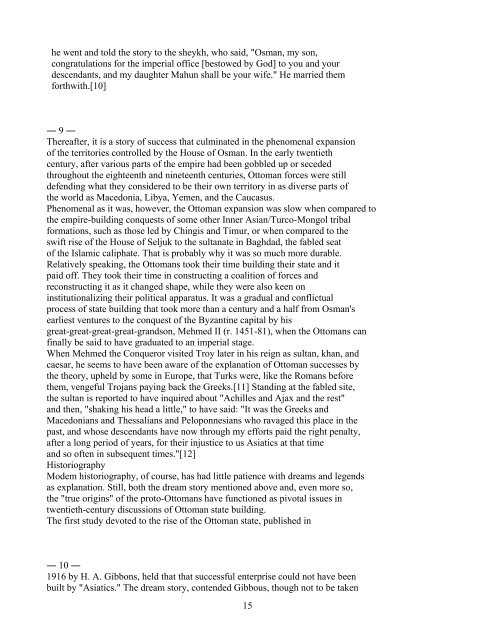Between Two Worlds Kafadar.pdf
Between Two Worlds Kafadar.pdf
Between Two Worlds Kafadar.pdf
You also want an ePaper? Increase the reach of your titles
YUMPU automatically turns print PDFs into web optimized ePapers that Google loves.
he went and told the story to the sheykh, who said, "Osman, my son,<br />
congratulations for the imperial office [bestowed by God] to you and your<br />
descendants, and my daughter Mahun shall be your wife." He married them<br />
forthwith.[10]<br />
― 9 ―<br />
Thereafter, it is a story of success that culminated in the phenomenal expansion<br />
of the territories controlled by the House of Osman. In the early twentieth<br />
century, after various parts of the empire had been gobbled up or seceded<br />
throughout the eighteenth and nineteenth centuries, Ottoman forces were still<br />
defending what they considered to be their own territory in as diverse parts of<br />
the world as Macedonia, Libya, Yemen, and the Caucasus.<br />
Phenomenal as it was, however, the Ottoman expansion was slow when compared to<br />
the empire-building conquests of some other Inner Asian/Turco-Mongol tribal<br />
formations, such as those led by Chingis and Timur, or when compared to the<br />
swift rise of the House of Seljuk to the sultanate in Baghdad, the fabled seat<br />
of the Islamic caliphate. That is probably why it was so much more durable.<br />
Relatively speaking, the Ottomans took their time building their state and it<br />
paid off. They took their time in constructing a coalition of forces and<br />
reconstructing it as it changed shape, while they were also keen on<br />
institutionalizing their political apparatus. It was a gradual and conflictual<br />
process of state building that took more than a century and a half from Osman's<br />
earliest ventures to the conquest of the Byzantine capital by his<br />
great-great-great-great-grandson, Mehmed II (r. 1451-81), when the Ottomans can<br />
finally be said to have graduated to an imperial stage.<br />
When Mehmed the Conqueror visited Troy later in his reign as sultan, khan, and<br />
caesar, he seems to have been aware of the explanation of Ottoman successes by<br />
the theory, upheld by some in Europe, that Turks were, like the Romans before<br />
them, vengeful Trojans paying back the Greeks.[11] Standing at the fabled site,<br />
the sultan is reported to have inquired about "Achilles and Ajax and the rest"<br />
and then, "shaking his head a little," to have said: "It was the Greeks and<br />
Macedonians and Thessalians and Peloponnesians who ravaged this place in the<br />
past, and whose descendants have now through my efforts paid the right penalty,<br />
after a long period of years, for their injustice to us Asiatics at that time<br />
and so often in subsequent times."[12]<br />
Historiography<br />
Modem historiography, of course, has had little patience with dreams and legends<br />
as explanation. Still, both the dream story mentioned above and, even more so,<br />
the "true origins" of the proto-Ottomans have functioned as pivotal issues in<br />
twentieth-century discussions of Ottoman state building.<br />
The first study devoted to the rise of the Ottoman state, published in<br />
― 10 ―<br />
1916 by H. A. Gibbons, held that that successful enterprise could not have been<br />
built by "Asiatics." The dream story, contended Gibbous, though not to be taken<br />
15













